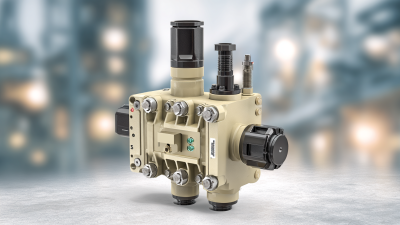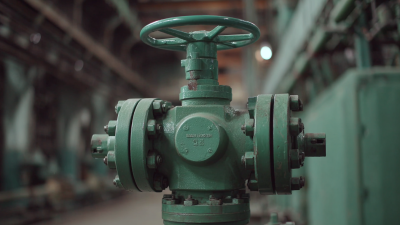In today's fast-paced global market, optimizing supply chains has become a critical priority for businesses striving for efficiency and competitiveness. According to a recent report by McKinsey, companies that successfully enhance their supply chain strategies can achieve cost savings of up to 20%, significantly improving their bottom line.

One innovative solution gaining traction is the integration of electric valves, which not only streamline operations but also enhance precision in fluid control processes. As reported by MarketsandMarkets, the electric valve market is expected to grow from USD 5.1 billion in 2021 to USD 7.3 billion by 2026, driven by the increasing demand for automation and improved process safety across various industries.
By leveraging electric valves, organizations can facilitate better global procurement practices, reduce maintenance costs, and ultimately create a more agile and responsive supply chain.
Electric valves play a pivotal role in modern supply chains by enhancing efficiency, reliability, and sustainability. According to a report by MarketsandMarkets, the global electric valve market is projected to reach USD 15.4 billion by 2025, growing at a CAGR of 6.1% from 2020. This growth is driven by the increasing demand for automation in various industries, including oil and gas, water and wastewater, and food and beverage. By integrating electric valves into supply chain processes, companies can ensure precise control of fluid flow, thereby minimizing waste and reducing operational costs.

In addition to cost savings, electric valves contribute to improved safety and compliance within supply chains. The International Society for Automation (ISA) emphasizes that the automation of valve control reduces human error and enhances process reliability. For instance, electric valves enable real-time monitoring and remote control, allowing for swift responses to changes in production demands or potential hazards. As industries increasingly prioritize sustainability, electric valves facilitate better resource management, supporting the transition toward greener supply chain practices. Leveraging these technologies can significantly enhance operational resilience and drive competitive advantage in a complex global marketplace.
Implementing electric valves in your supply chain can significantly enhance procurement efficiency, particularly on a global scale. One of the primary benefits is their ability to provide precise control over fluid flow, which leads to improved process reliability. In industries where timing and accuracy are crucial, electric valves can help streamline operations and reduce the risks associated with manual adjustments.
TIP: To maximize the advantages of electric valves, ensure that they are integrated with automated monitoring systems. This allows for real-time data analysis, enabling teams to identify potential issues before they escalate and ensuring consistent supply chain performance.
Another key benefit of electric valves is their energy efficiency. By reducing the need for excessive manual operations and optimizing flow control, they contribute to lower energy consumption, which is increasingly important in today’s sustainability-focused market. This not only decreases operational costs but also aligns with corporate social responsibility goals.
TIP: When selecting electric valves, consider their compatibility with existing systems and assess the long-term savings on maintenance and energy costs. A thorough evaluation will pave the way for a smoother transition and enhanced procurement strategies globally.
| Dimension | Description | Key Benefits |
|---|---|---|
| Efficiency | Electric valves offer faster response times and improved control of fluid dynamics. | Reduces operational delays, enhancing overall productivity. |
| Cost Savings | Initial investment in electric valves often leads to lower maintenance costs. | Minimizes long-term operational expenses. |
| Sustainability | Electric valves are often more environmentally friendly, using less energy than pneumatic counterparts. | Contributes to corporate sustainability goals. |
| Integration | They can be easily integrated into existing automation systems. | Facilitates smoother transition and upgrades. |
| Safety | Electric valves improve safety features, allowing for precise control and reliable operation. | Reduces risk of accidents related to fluid control. |
Integrating electric valves into your supply chain operations can significantly enhance efficiency and reliability. According to a report by Markets and Markets, the global electric valve market is expected to reach $4.3 billion by 2025, growing at a CAGR of 6.8%. This growth is largely driven by the increasing demand for automation across various industries, including oil and gas, water treatment, and chemical processing. By leveraging electric valves, companies can achieve precise flow control and minimize energy consumption, which are crucial for optimizing supply chain management.
Moreover, implementing electric valves can streamline procurement processes. A study by Grand View Research indicates that advanced valve technologies can reduce maintenance costs by up to 30% and downtime by 20%, offering significant savings in operational expenses. When integrating these intelligent systems, businesses should focus on supplier collaboration, allowing for seamless communication and faster adaptation to changes in demand. By aligning procurement strategies with advanced technologies, organizations can not only enhance their supply chain resilience but also remain competitive in a rapidly evolving market.
When sourcing electric valves from international suppliers, it's essential to adopt best practices that can optimize your procurement process. One key tip is to thoroughly assess potential suppliers by evaluating their certifications and industry experience. Look for vendors who comply with international standards and have a robust track record in delivering quality products. This can significantly reduce the risk of delays and quality issues down the line.
Another important practice is to establish clear communication channels with your suppliers. This includes discussing specifications, lead times, and shipping options transparently. Utilizing technology such as supplier management software can facilitate smoother interactions, ensuring that all parties are aligned on expectations. Additionally, consider building strong relationships with multiple suppliers to diversify your risk and have backup options in case of disruptions.
Finally, it’s crucial to stay updated on global market trends that could impact your supply chain. Regularly reviewing economic indicators and regulatory changes in the countries where you source electric valves can help you anticipate potential challenges. By adopting these strategies, you can streamline your supply chain effectively and enhance your procurement experience.
The future of supply chain efficiency is increasingly intertwined with advancements in electric valve technology. As industries strive for greater automation and precision, electric valves offer an intelligent solution that enhances control over fluid dynamics. These devices facilitate faster response times and reduce the risk of mechanical failure, making them a crucial component in modern supply chain operations. With their ability to integrate seamlessly into existing systems, electric valves are revolutionizing traditional workflows, promoting a more streamlined procurement process.
Moreover, the trend towards smart technology in supply chains is further pushing the relevance of electric valves. As IoT devices gain traction, the capability to monitor and control electric valves remotely will allow organizations to optimize operations in real-time. This not only minimizes downtime but also enhances decision-making with data-driven insights. As global procurement continues to evolve, the embrace of electric valves will undoubtedly lead to increased efficiency, reduced costs, and improved sustainability within the supply chain landscape. Companies that proactively incorporate these technologies will be well-positioned to lead in their respective markets.






